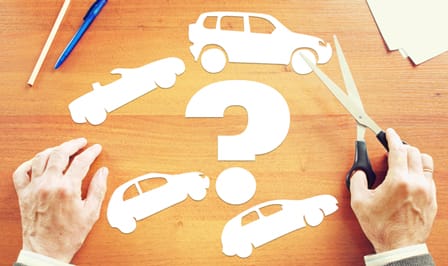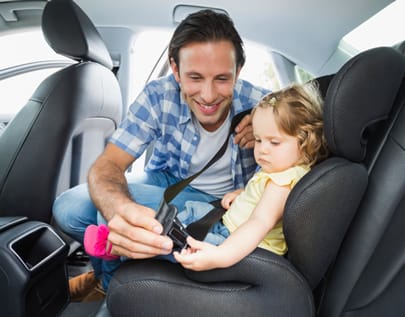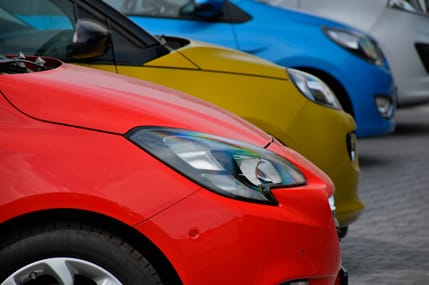When your passengers are your family, safety will no doubt be high on your priority list when buying a new car. Ok cool, you just need to find something that is safe and good value for money right? Sure, when you say it fast it might sound like a breeze. Oh, then you realise there can be a lot to consider and what started off seeming like a fun experience may even become a challenging one.
When it comes to car safety there can be a lot to think about. What cars are the safest cars for you and your family? What safety features do you need? How much do you need to pay to get a safe car?
Fortunately, there is a lot of information to help narrow down your choice and you don’t have to blow out your budget to find a safe car. Check out this quick guide to car safety to help make an educated decision and ensure you buy one of the safest cars in Australia and a car that is right for your needs.
Small or Large Vehicle?
 When it comes to safety, many people think that bigger cars are going to be safer. It’s a common misconception that bigger equals safer. Many people assume that larger and heavier vehicles keep passengers safer in a crash and so SUVs, minivans and trucks must be safer vehicles. While historically there is some truth to that, the good news is that many new models of small cars rate extremely well in safety tests as well. So even if you desire safety with your new car you don’t have to get a big car or SUV to get it.
When it comes to safety, many people think that bigger cars are going to be safer. It’s a common misconception that bigger equals safer. Many people assume that larger and heavier vehicles keep passengers safer in a crash and so SUVs, minivans and trucks must be safer vehicles. While historically there is some truth to that, the good news is that many new models of small cars rate extremely well in safety tests as well. So even if you desire safety with your new car you don’t have to get a big car or SUV to get it.
Consider Vehicle Crash Tests
It is ideal for a car that is involved in a crash to absorb as much of the impact as possible. That way, your body is much less likely to take on the impact of the crash. Cars are designed to crumple in a crash to absorb impact. A lot of thought and research goes into modern car design so the car crumples in certain ways to deal with the most likely impact areas when involved in a crash. The safest small cars will be able to absorb significant impact without crushing passengers. That is a major contributing factor to a car achieving a high crash test rating.
Check out the crash test rating before buying a car. Granted, the hope is that you won’t ever need to see just how safe your car is during a crash but it is reassuring to know your car is well designed in the event of a crash. Many crash test ratings can rate the safety features of the vehicle including airbags and crash avoidance systems.
Researching Your New Car
A quick way to determine the safety rating of a potential car is to look up the make and model on the Australasian New Car Assessment Program’s website. If you’re researching a used car, make sure to look at the Used Car Safety Ratings website to see how your car holds up after it has passed through the hands of many owners. These websites give your car, or your potential car, a rating based on crash test safety and consumer feedback on used cars.
Is It Safe for Children?
You want to ensure your car is safe enough for your children if you’re planning on driving around little ones. Some cars offer better safety ratings for smaller passengers. This includes car seat safety ratings and special airbags designed just for smaller passengers. These ratings tend to focus on the safety of passengers sitting in the backseat instead of the front seat.
Crash Avoidance Systems
Performing well in a crash is important but it is of course best to avoid a crash where possible and some cars integrate technology to help with that. New cars are built with varying levels of crash avoidance systems. These have greatly enhanced over recent years. Some features of crash avoidance systems include automatic braking, rear view cameras, course correction and blind spot monitoring. While these systems should not be relied on to replace safe driving habits, they have been known to decrease the likelihood of a crash in some common crash scenarios.
Automatic Braking
Automatic braking sensors force a car to stop if an object moves in the vehicles path. This can include small children running in the path of the car and even inanimate objects like trolleys and rubbish bins. In addition to the safety of passengers within the car, automatic braking can potentially save the life of someone in the path of your car and can save your car from unnecessary damage from a rogue object. These can also be extremely helpful if another car backs out behind you or if a cyclist passes through your blind spot. In addition to the health and safety benefits of crash avoidance the technology can also help save you money from minor prangs and scrapes.
Rear View Cameras
Rear view cameras are another type of crash avoidance system that are similar to automatic braking. In fact, they were the precursor to automatic braking. This small camera simply allows you to see the blind spot behind your vehicle as your car is backing up. Although you still need to look behind your vehicle for obstructions, the camera can help you avoid small animals, objects and children that are difficult to see without the camera.
Adaptive Headlights
Adaptive headlights have transformed the way we see the streets at night. They can help drivers see the roads better by turning with the vehicle as the driver turns the steering wheel. There is some anecdotal evidence from drivers that adaptive headlights have helped them to avoid accidents and see roads better. However, the industry doesn’t have enough research yet to make substantial claims regarding crash safety.
Course Correction
Crash avoidance through course correction is one of the most sophisticated safety systems available on the market. This technology actually allows the vehicle to swerve to avoid a collision. The technology can also sense when the driver is going to drift out of a lane and course correct to help bring the driver’s attention back into focus. These systems are just starting to be offered on some newer models and are not available on most used cars.
Blind Spot Monitoring
Blind spot monitoring systems can also help drivers monitor blind spots. These are usually available on the rear view mirrors. If a car is in the drivers blind spot, a small red light will illuminate on the passenger-side and driver-side rear view mirrors. The driver can then double check to see if there is indeed a car in the blind spot or wait until the road is clear to make a turn or switch lanes. This type of technology has been extremely helpful in avoiding a common scenario that leads to crashes on multilane highways.
Used or New Vehicles?
If you are considering getting a used car you will probably need to do a little extra research to determine if the car you are considering gets good safety ratings. First, you’ll need to determine that cars safety rating as a new car. Then you’ll need to look up how your desired car tested in used car safety ratings. However, you’ll also then want to make sure the car has a clean history without any significant accidents. You will also need to ensure everything is in good working order and a mechanical check is advised even when a used car has a safety certificate.
Driver Comfort
Driver comfort can be overlooked when it comes to safety, yet the comfort of you as a driver is extremely important. Make sure you can adjust the seats as necessary to comfortably reach the pedals and steering wheel. Make sure that there is plenty of leg and headroom as well. The drivers headrest is also important. Make sure that the headrest will secure your head in place during a collision to avoid whiplash and other cranial spinal injuries. The safest car for your family must also be a comfortable car for you to drive.
Consider the Colour
 Did you know that the colour of the car can affect its safety rating? It turns out, white cars are the ones that are least likely to get into an accident. Some black cars can be harder to see on the road and visibility for other drivers is a valid safety consideration. White cars can also be the best cars to keep you cool in hot weather.
Did you know that the colour of the car can affect its safety rating? It turns out, white cars are the ones that are least likely to get into an accident. Some black cars can be harder to see on the road and visibility for other drivers is a valid safety consideration. White cars can also be the best cars to keep you cool in hot weather.
Four Wheel or Two Wheel Drive?
Many drivers assume that a four-wheel drive system will automatically be safer than a car with two-wheel drive. If you live in an area that experiences slippery conditions or mountainous roads, a four-wheel drive may help you avoid an accident. Yet some cars with four-wheel drive can be at higher risk for rolling over and this can actually increase if the driver isn’t used to handling a car with four-wheel drive. Like all types of cars, there are some four-wheel drives which are safer than others and research into the safety rating is still advised.
What’s it All Mean for You?
The good news for you as a buyer is that the safest cars on the market aren’t always the most expensive. It’s not just the luxury cars on the market that offer excellent safety features like rear view cameras and blind spot indicators. One of the best ways to find a car that’s safe for your family is to review safety ratings and get independent advice from an expert.
You may not have the time to stay up to date with car safety reviews and to thoroughly inspect the wide range of cars on the market. If that’s the case, you may appreciate the car buying service offered by our team at Car Search Brokers. We can help you make an informed decision on your next car purchase whether new or used. As well as keeping up to date on car safety ratings and being able to share that advice with you, our services can include thorough mechanical checks and vehicle inspections to find the best cars on the market for your needs.
